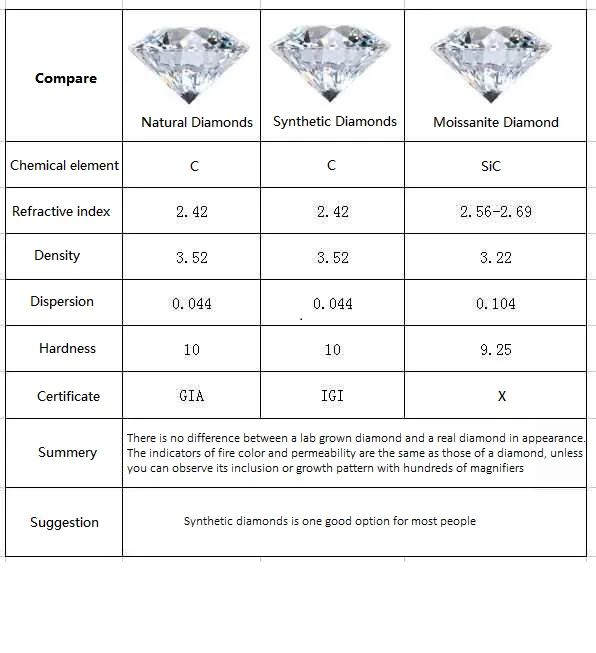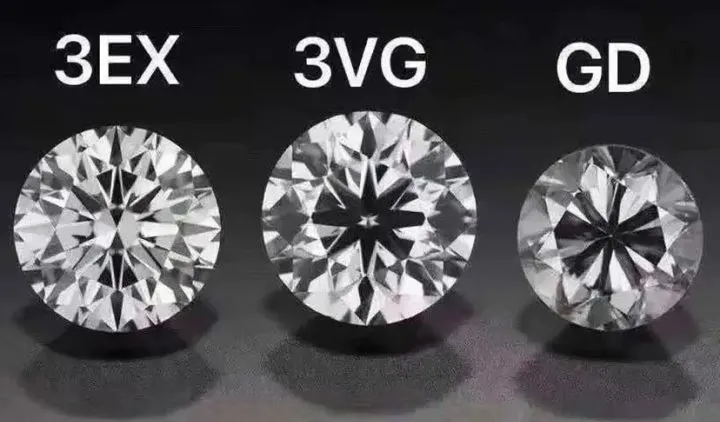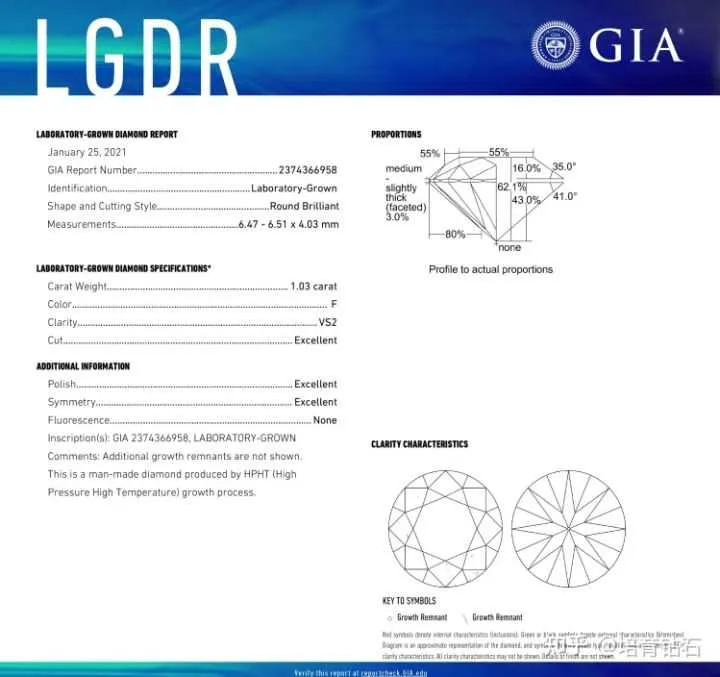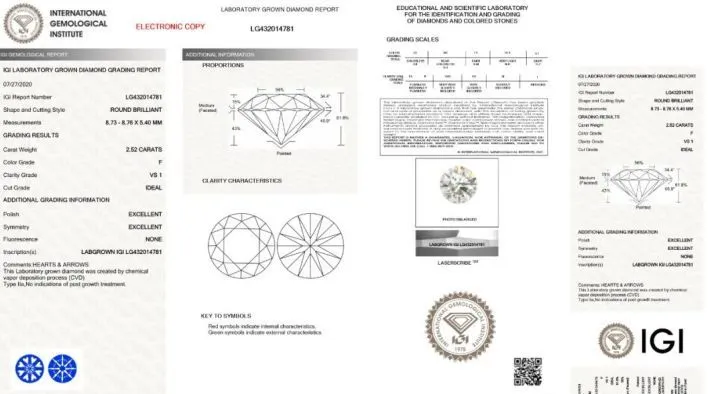author:airui time:2022-11-04 09:58:21 view:[58]
The lab-grown diamond in the laboratory is manufactured artificially by using high and new technology in the laboratory. The physical, chemical, and optical aspects are 100% the same as those of diamond mining. The difference is only in the way they come from. In short, diamonds made in the laboratory are real diamonds, just like diamonds mined. They are only made in the laboratory, not taken from the mine.
In short, lab-grown diamonds is more environmentally friendly because they are not mined. Diamond mining can cause serious environmental damage. To find a one-carat diamond, 88000 to 176000 pounds of dirt must be screened. This means that the diamond mine is one of the largest man-made caves on the earth, which has seriously affected the ecosystem. On the other hand, diamonds are produced in a controlled environment with minimal impact on the environment.
It may have never occurred to anyone centuries ago that 100% real diamonds could be lab-grown one day - diamonds produced in the underground growth environment have the same optical, chemical, and physical properties. Therefore, the lab-grown diamonds also adopt the international standard 4C identification (color, clarity, cut, carat), and also have GIA/IGI/HRD/NGTC and other international well-known diamond identification reports, endorsed by FTC and JCK News-related authorities.
In the diamond customization industry, it is a wise choice to lab-grown diamonds with diverse colors, high clarity, and affordable prices. The lab-grown diamonds in the laboratory have come into people's view. In just a few years, lab-grown diamonds in the laboratory have been accepted by more and more people and have become a new choice for daily wear and wedding jewelry. However, with the recent entry of major brands into the field of CVD diamond growing, this topic has once again been put on the cusp of the storm, triggering a new round of discussion. Lab-grown diamonds are real diamonds in every aspect. Its chemical, physical, atomic, optical, and all characteristics are the same as those of natural diamonds.
Is artificial diamond worth buying?" "Can you buy lab-grown diamonds? Natural diamonds are IQ tax?" Recently, the topic of lab-grown diamonds is extremely hot. As a practitioner who has been engaged in customizing diamond jewelry and diamond rings for more than 10 years, he has seen a lot of confusion about lab-grown diamonds, and many netizens have asked how to choose lab-grown diamonds. Therefore, this article is mainly intended to tell ordinary consumers how to choose to lab-grown diamonds, where to buy customized diamond jewelry is relatively safe, and the quality of after-sales goods can be guaranteed.
As we all know, the price of natural diamonds is very expensive. The more large carat diamonds are, the higher the price is. In recent years, affected by the new crown epidemic and the international situation, the price of natural diamonds is getting higher and higher. The economic situation is not good. "The naked eye can't tell the difference, the price is lower." High-quality and inexpensive lab-grown diamonds are gradually favored by the market.
Lab-grown diamonds refer to diamonds manufactured manually in laboratories or factories, also known as laboratory synthetic diamonds, CVD diamonds, etc. Nowadays, lab-grown diamonds are becoming a popular choice for jewelry. The manufacturing process of lab-grown diamonds is formed by using advanced technology. lab-grown diamonds are essentially the same as natural diamonds in chemical, optical, and physical properties and crystal structure. Their relationship may be analogous to the ice in the natural environment and the ice formed in the refrigerator. Although the places and conditions of formation are different, the essence is the same.

The lab-grown diamond in the laboratory refers to the diamond lab grown by scientists in the laboratory. Its constituent elements, physical, chemical, and optical properties are the same as those of natural diamonds, so it can not be distinguished by naked eyes, magnifiers, or even microscopes. Is it a fake diamond? To be sure: No! As mentioned earlier, the physical and chemical properties are the same, so they are genuine diamonds. The focus is on whether the seller informs the source of the diamond.
How are diamonds made? At present, there are two methods for making synthetic diamonds. Normally, a diamond grown in the laboratory starts with a tiny diamond seed. The seeds are placed in a chamber called a plasma reactor (in the case of CVD synthesis) or a large mechanical press (if manufactured by HPHT). Then, according to the technology used, some combination of heat, pressure, and carbon source is used to make the crystal grow layer by layer.
Natural diamonds take thousands of years to form in the natural environment, and diamond synthesis is the process of growing a small diamond under the technology of science and technology. In the laboratory, advanced equipment and cutting-edge technology are used to restore the natural environment. Small diamonds are used as the seeds of diamonds and put into the culture bin to provide atomic structure for growth. In the incubator, the temperature and pressure will rise rapidly, simulating the high-temperature and high-pressure environment of the earth's depth, and creating harsh conditions for natural diamond travel artificially. When the carbon source is added to the culture bin, the chemical bond between the carbon atoms in the raw materials will break under an environment of high temperature and high pressure and become free carbon atoms. The free carbon atoms will be attracted by the nearby diamond seeds and combined with them so that the diamond seeds will gradually grow.
Here, the two technologies begin to grow from the seed of a diamond. HPHT has granular diamonds as the seed, simulating the high temperature and high pressure of natural diamond growth in the mantle, and gradually crystallizing the diamond seed. CVD is a polished diamond slice, and the carbon element in the growth chamber gradually becomes larger.
Both are 100% diamonds recognized by the industry, not fake diamonds or imitation diamonds. The same elements, hardness, and refractive index as natural diamonds.
What's the reason for synthetic a small diamond into a big one? If you put a small diamond in the mantle, it will also grow into a big one. The essential difference between them is the different growth environments.
HPHT high temperature and high pressure are characterized by high color grade, mainly the color, and the biggest disadvantage are within 3 carats. CVD chemical vapor deposition is characterized by large carats, which can be made into 5-6 carats or even 10 carats, with a large color span. Different colors are available, and some of the poor color levels need to be improved.
There is no difference between a lab-grown diamond and a real diamond in appearance. The indicators of fire color and permeability are the same as those of a diamond unless you can observe its inclusion or growth pattern with hundreds of magnifiers. There is no way to distinguish between the two simply from the naked eye. If you want to buy a lab-grown diamond for decoration, I can tell you responsibly that there is no problem at all, Just buy it with confidence.

Natural diamonds vs diamonds lab grown in the laboratory: all are crystals composed of carbon element, all optical, physical and chemical properties are the same, hardness 10, dispersion 0.044, refractive index 2.417, and specific gravity 3.52. lab grown diamonds=laboratory lab grown diamonds=artificial diamonds=synthetic diamonds ≠ Mozambique diamonds ≠ cubic zirconia. The first four are all talking about the same product, all diamonds, but the growing environment is in the laboratory rather than in nature. The last two are very similar to diamonds in length, but they are completely different in nature. Both the Moissanite and cubic zirconia are fake diamonds.
Like natural diamonds, synthetic diamonds also depends on the 4C of diamonds. First, let's understand what the 4C of diamonds is. I believe that friends have read dozens of articles about the 4C of diamonds. To sum up, the price of diamond cultivation is determined by the 4C of diamond cultivation.
Diamond 4C refers to the carat weight, clarity, color, and cut of the diamond.
lab-grown diamond price=weight+color+clarity+cutting.
Diamonds are measured in carats (also called cards). 1 carat=200 mg=0.2 g. One carat is divided into one hundred portions, and each portion is called one point.
If the diamond is real, consumers generally recommend to choose a diamond with a score of more than 30 points when making a wedding ring. However, since the price of diamond is more affordable, they can choose a diamond with a score of more than 50 points.
The highest cost-performance ratio of diamonds is 50-79 points, which is low in price and highly accepted by the public. Students with a higher budget can choose 80-99 points.
The whitest diamond is rated D (starting from the first letter of the Diamond). The color of diamonds can be divided into 11 levels, namely D, E, F, G, H, I, J, K, L, M,
For natural diamonds, it is generally recommended to choose natural diamonds above the H color. For synthetic diamonds, on the one hand, the process of synthetic diamonds can be controlled, so diamonds with higher quality can be produced. On the other hand, the price of synthetic diamonds is more competitive than that of natural diamonds. Therefore, DEF color is also the color we can consider.
Diamonds inevitably contain various impurities or defects in the growth process. The color, number, size and location of these inclusions have different effects on the clarity of diamonds.
The clarity of diamonds is usually graded by using 10 times magnifying glasses to classify the internal and surface defects of diamonds and their influence on luster. The standard is subdivided into 10 levels, including LC, VVS1, VVS2, VS1, VS2, SI1, SI2, P1, P2 and P3.
Under the same budget, it is generally recommended that the purity of natural diamonds should be above SI, and that of diamonds for cultivation should be above VS or even VVS. The effect is better. After all, the diamonds for cultivation should be purchased.
Good cutting should reflect the brightness and fire color of the diamond as much as possible, and try to keep the weight of the original stone. The cutting grades of IGI International Gemology Institute are divided into ID (standard), EX (excellent), VG (very good) and G (good) from high to low.

Cut is the only measure that is operated by technicians, and it is an important factor to improve the beauty of diamonds. The size, proportion, symmetry and polishing effect of cutting diamond surface, together with the change of cutting surface angle, can produce diamond diamond luster with Brilliance, Distinction and Scintillation. The ideal standard for cutting and grinding is to show the three fire colors equally.
Table: 52.4~57.5%
Total Depth: 56.88%~63.92%
Girdle: Thin to Slightly Thick (0.51%~2.95%)
Crown Angle: 33.7~ 35.8
Pavilion Angle: 40.2~ 41.25
Culet: None (Pointed)~Medium
To sum up, when we purchase lab-grown diamonds, it is recommended to select lab-grown diamonds with more than 50 points, DE color, VS1 clarity and 3EX cutting.
The price of lab-grown diamonds varies greatly. At present, the price is also unstable. Generally, a 1-carat DE color VS1 clarity, 3EX cut, is about 1500$. Compared with natural diamonds, the price is only one-seventh or even one-eighth.
At present, GIA, IGI and NGTC are the most authoritative in synthetic diamonds, among which the IGI certificate is the most common and is the mainstream certificate for synthetic diamonds.
(1).GIA certificates. At present, GIA only produces electronic certificates for synthetic diamonds. The paper certificates we see every day, such as those shown in Figure 1, are just new electronic certificates printed by businesses themselves. The layout design of the GIA lab-grown diamond certificate is different from that of a natural diamond certificate. The front cover and inner page are printed with the word "LGDR" in white on a blue background. The product name and remarks are the same as those of IGI, but GIA is about 2000 more expensive than IGI for a one-carat certificate. Like IGI, GIA also has small certificates, which do not have a clear description chart.

(2). IGI certificates. IGI has certificates and certificates. Shanghai IGI certificates are the most popular in China. When purchasing, you'd better choose Shanghai IGI certificates. Shanghai IGI certificates have the most comprehensive information and strict inspection standards.

(3). NGTC certificate. NGTC is the national jewelry and jade quality supervision and inspection center. The NGTC certificate can be said to be a benchmark for the GIA certificate. The inspection standard is quite strict. There is no problem in buying HPHT synthetic diamonds and choosing the NGTC certificate. The only regret is that if you buy CVD cultivate diamonds, you will have to polish your eyes. There is no indication of whether to change the color, so some CVD diamonds that change the color are easy to fish in troubled waters.
(4). The full name of the NGIC certificate is the National Gem and Jade Quality Supervision and Inspection Center. The NGIC certificate is a national certificate of China. In addition, the NGTC is also the only partner of the American Gemological Institute (GIA) in mainland China.
More and more synthetic diamonds appear on the market, almost identical to natural diamonds in terms of composition, structure and color. According to the survey, China is the world's first producer of lab-grown diamonds, with 80% of domestic production capacity coming from Henan. Around Henan, an industrial cluster has been formed around the cultivation of diamond production and sales, and many listed companies have been born. Although synthetic diamonds have just become popular and have entered the public's view, it has a long history. Now the market demand for synthetic diamonds is very large, which generally falls short of demand. All companies focus on production capacity.
